Elimination of Common Mode Voltage in the Three-To-Nine-Phase Matrix Converter
Abstract
1. Introduction
2. Three-to-Nine-Phase Matrix Converter Topology
3. Switching Configurations in the Three-to-Nine-Phase MC
4. Output Voltage Space Vectors Eliminating the CMV
- 1458 combinations for the output voltage space vectors with variable both module and phase angle on the complex plane;
- 162 combinations for active output voltage space vectors with variable modules and fixed phase angle on the complex plane;
- 54 combinations for the output voltage represented by rotating voltage space vectors with constant module and constant angular speed on complex plane;
- 6 combinations for zero output voltage space vectors.
5. Method of Modulation
6. Simulation Results
7. Conclusions
Author Contributions
Funding
Conflicts of Interest
References
- Empringham, L.; Kolar, J.W.; Rodriguez, J.; Wheeler, P.W.; Clare, J.C. Technological Issues and Industrial Application of Matrix Converters: A Review. IEEE Trans. Ind. Electr. 2013, 60, 4260–4271. [Google Scholar] [CrossRef]
- Zhang, J.; Li, L.; Dorrell, D. Control and Applications of Direct Matrix Converters: A Review. Chin. J. Electr. Eng. 2018, 4, 18–27. [Google Scholar]
- Ali, M.; Iqbal, A.; Khan, R.; Ayyub, M.; Anees, M. Generalized Theory and Analysis of Scalar Modulation Techniques for a m x n Matrix Converter. IEEE Trans. Power Electron. 2017, 32, 4864–4877. [Google Scholar] [CrossRef]
- Rodriguez, J.; Rivera, M.; Kolar, J.W.; Wheeler, P.W. A Review of Control and Modulation Methods for Matrix Converters. IEEE Trans. Ind. Electr. 2012, 59, 58–70. [Google Scholar] [CrossRef]
- Trentin, A.; Zanchetta, P.; Empringham, L.; de Lillo, L.; Wheeler, P.; Clare, J. Experimental Comparison Between Direct Matrix Converter and Indirect Matrix Converter Based on Efficiency. In Proceedings of the 2015 IEEE Energy Conversion Congress and Exposition (ECCE), Montreal, Canada, 20–24 September 2015. [Google Scholar]
- Jussila, M.; Tuusa, H. Comparision of Direct and Indirect Matrix Converters in Induction Motor Drive. In Proceedings of the IECON 2006-32nd Annual Conference on IEEE Industrial Electronics, Paris, France, 6–10 November 2006. [Google Scholar]
- Kolar, J.W.; Friedli, T.; Rodriguez, J.; Wheeler, P.W. Review of Three-Phase PWM AC-AC Converter Topologies. IEEE Trans. Ind. Electr. 2011, 58, 4988–5006. [Google Scholar] [CrossRef]
- Abdel-Rahim, O.; Abu-Rub, H.; Kouzou, A. Nine-to-Three Phase Direct Matrix Converter with Model Predictive Control for Wind Generation System. Energy Procedia 2013, 42, 173–182. [Google Scholar] [CrossRef]
- Abdel-Rahim, O.; Ali, Z.M. Control of Seven-to-Three Phase Direct Matrix Converter Using Model Predictive Control for Multiphase Wind Generation. In Proceedings of the 2014 16th International Conference on Harmonics and Quality of Power (ICHQP), Bucharest, Romania, 25–28 May 2014. [Google Scholar]
- Yamamoto, E.; Hara, H.; Uchino, T.; Kawaji, M.; Kume, T.J.; Kang, J.K.; Krug, H.P. Development of MCs and its Applications in Industry. IEEE Ind. Electron. Mag. 2011, 5, 4–12. [Google Scholar] [CrossRef]
- Kang, J.; Kume, T.; Hara, H.; Yamamoto, E. Common-mode voltage characteristics of matrix converter-driven AC machines. In Proceedings of the Fourtieth IAS Annual Meeting. Conference Record of the 2005 Industry Applications Conference, Kowloon, Hong Kong, China, 2–6 October 2005; Volume 4, pp. 2382–2387. [Google Scholar]
- Vijayagopal, M.; Empringham, L.; de Lillo, L.; Tarisciotti, L.; Zanchetta, P.; Wheeler, P. Control of a direct matrix converter induction motor drive with modulated model predictive control. In Proceedings of the 2015 IEEE Energy Conversion Congress and Exposition (ECCE), Montreal, Canada, 20–24 September 2015; pp. 4315–4321. [Google Scholar]
- Gupta, R.K.; Mohapatra, K.K.; Somani, A.; Mohan, N. Direct-Matrix-Converter-Based Drive for a Three-Phase Open-End-Winding AC Machine with Advanced Features. IEEE Trans. Ind. Electr. 2010, 57, 4032–4042. [Google Scholar] [CrossRef]
- Zhang, J.; Li, L.; Dorrell, D.; Guo, Y. Direct Torque Control with a Modified Switching Table for a Direct Matrix Converter based AC Motor Drive System. In Proceedings of the 2017 20th International Conference on Electrical Machines and Systems (ICEMS), Sydney, Australia, 11–14 August 2017; pp. 1–6. [Google Scholar]
- Munuswamy, I.; Wheeler, P.W. Matrix Converter for More Electric Aircraft; IntechOpen: London, UK, 2019. [Google Scholar]
- Levi, E.; Bojoi, R.; Profumo, F.; Toliyat, H.A.; Williamson, S. Multiphase induction motor drives–a technology status review. IET Electr. Power Appl. 2007, 1, 489–516. [Google Scholar] [CrossRef]
- Ahmed, S.M.; Iqbal, A.; Abu-Rub, H.; Rodriguez, J.; Rojas, C.; Saleh, M. Simple Carrier-Based PWM Technique for a Three-to-Nine-Phase Direct AC-AC Converter. IEEE Trans. Ind. Electr. 2011, 58, 5014–5023. [Google Scholar]
- Dabour, S.M.; Allam, S.M.; Rashad, E.M. Indirect Space-Vector PWM Technique for Three to Nine Phase Matrix Converters. In Proceedings of the IEEE GCC Conference and Exhibition, Muscat, Oman, 1–4 February 2015. [Google Scholar]
- Kalaiselvi, J.; Srinivas, S. Bearing Currents and Shaft Voltage Reduction in Dual-Inverter-Fed Open-End Winding Induction Motor with Reduced CMV PWM Methods. IEEE Trans. Ind. Electr. 2015, 62, 144–152. [Google Scholar] [CrossRef]
- Ahmed, S.; Abu-Rub, H.; Salam, Z. Common-Mode Voltage Elimination in a Three-to-Five-Phase Dual Matrix Converter Feeding a Five-Phase Open-End Drive Using Space-Vector Modulation Technique. IEEE Trans. Ind. Electr. 2015, 62, 6051–6063. [Google Scholar] [CrossRef]
- Dabour, S.M.; Abdel-Khalik, A.S.; Ahmed, S.; Massoud, A. Common-Mode Voltage Reduction of Matrix Converter fed Seven-Phase Induction Machine. In Proceedings of the 2016 XXII International Conference on Electrical Machines (ICEM), Lausanne, Switzerland, 4–7 September 2016. [Google Scholar]
- Rząsa, J. Control of a matrix converter with reduction of a common mode voltage. In Proceedings of the IEEE Compatibility in Power Electronics, Gdynia, Poland, 12–15 September 2005. [Google Scholar]
- Mohapatra, K.K.; Ned, M. Open-End Winding Induction Motor Driven with Matrix Converter for Common-Mode Elimination. In Proceedings of the International Conference on Power Electronics, Drives and Energy Systems, New Delhi, India, 12–15 December 2006. [Google Scholar]
- Rząsa, J. Research on Dual Matrix Converter Feeding an Open-End-Winding Load Controlled with the Use of Rotating Space Vectors. Part I. In Proceedings of the IECON 2013-39th Annual Conference of the IEEE Industrial Electronics Society, Vienna, Austria, 10–13 November 2013. [Google Scholar]
- Rząsa, J.; Garus, G. Research on Dual Matrix Converter Feeding an Open-End-Winding Load Controlled with the Use of Rotating Space Vectors. Part II. In Proceedings of the IECON 2013-39th Annual Conference of the IEEE Industrial Electronics Society, Vienna, Austria, 10–13 November 2013. [Google Scholar]
- Baranwal, R.; Basu, K.; Mohan, N. An Alternative Carrier based implementation of Space Vector PWM for Dual Matrix Converter Drive with Common Mode Voltage Elimination. In Proceedings of the IECON 2014-40th Annual Conference of the IEEE Industrial Electronics Society, Dallas, TX, USA, 29 October–1 November 2014. [Google Scholar]
- Rząsa, J. An Alternative Carrier-Based Implementation of Space Vector Modulation to Eliminate Common Mode Voltage in a Multilevel Matrix Converter. Electronics 2019, 8, 190. [Google Scholar] [CrossRef]
- Rząsa, J.; Sztajmec, E. Elimination of Common Mode Voltage in Three-To-Six-Phase Matrix Converter. Energies 2019, 12, 1662. [Google Scholar] [CrossRef]
- Nguyen, N.H.; Lee, H.H. A Modulation Scheme for Matrix Converters with Perfect Zero Common-Mode Voltage. IEEE Trans. Power Electron. 2016, 31, 5411–5422. [Google Scholar] [CrossRef]
- Lei, J.; Feng, S.; Zhou, B.; Nguyen, H.; Zhao, J.; Chen, W. Simple Modulation Scheme with Zero Common-Mode Voltage and Improved Efficiency for Direct Matrix Converter Fed PMSM Drives. IEEE J. Emerg. Sel. Top. Power Electron. 2019. [Google Scholar] [CrossRef]
- Wang, D.; Tang, S.; Wang, J.; Xiong, Z.; Mo, S.; Yin, X.; Shuai, Z.; Shen, Z.J. Commutation Strategies for Single-Chip Dual-Gate Bidirectional IGBTs in Matrix Converters. In Proceedings of the 2016 IEEE Energy Conversion Congress and Exposition (ECCE), Milwaukee, WI, USA, 18–22 September 2017. [Google Scholar]
- Wang, L.; Dan, H.; Zhao, Y.; Zhu, Q.; Peng, T.; Sun, Y.; Wheeler, P. A Finite Control Set Model Predictive Control Method for Matrix Converter with Zero Common-Mode Voltage. IEEE J. Emerg. Sel. Top. Power Electron. 2017, 6, 327–338. [Google Scholar] [CrossRef]
- Linhart, L.; Lettl, J.; Bauer, J. Matrix Converter Two-Step Commutation Method Limitations. In Proceedings of the 14th International Power Electronics and Motion Control Conference EPE-PEMC 2010, Ohrid, Macedonia, 6–8 September 2010. [Google Scholar]
- Hao, L.; Ziling, N.; Ye, Z. A New Controlled Commutation Strategies for Matrix Converter. In Proceedings of the 2008 International Symposium on Computer Science and Computational Technology, Shanghai, China, 20–22 December 2008. [Google Scholar]
- Hendawi, E.; Khater, F.; Shaltout, A. Analysis, Simulation and Implementation of the Space Vector Pulse Width Modulation Inverter. In Proceedings of the 9th WSEAS International Conference on Applications of Electrical Engineering, Rodos, Greece, 22–24 July 2009. [Google Scholar]
- Alesina, A.; Venturini, M. Analysis and Design of Optimum-Amplitude Nine-Switch Direct AC-AC. IEEE Trans. Power Electron. 1989, 4, 101–112. [Google Scholar] [CrossRef]
- Alesina, A.; Ventrurini, M. Solid-State Power Conversion: A Fourier Analysis Approach to Generalized Transformer Synthesis. IEEE Trans. Circuits Syst. 1981, 28, 319–330. [Google Scholar] [CrossRef]
- Gyugyi, L.; Pelly, B.R. Static Power Frequency Changers; John Wiley & Sons: Hoboken, NJ, USA, 1976. [Google Scholar]
- Venturini, M.; Alesina, A. The Generalised Transformer: A New Bidirectional, Sinusoidal Waveform Frequency Converter with Continuously Adjustable Input Power Factor. In Proceedings of the 1980 IEEE Power Electronics Specialists Conference, Atlanta, GA, USA, 16–20 June 1980. [Google Scholar]
- Bucknall, R.W.G.; Ciaramella, K.M. On the Conceptual Design and Performance of a Matrix Converter for Marine Electric Propulsion. IEEE Trans. Power Electr. 2010, 25, 1497–1508. [Google Scholar] [CrossRef]
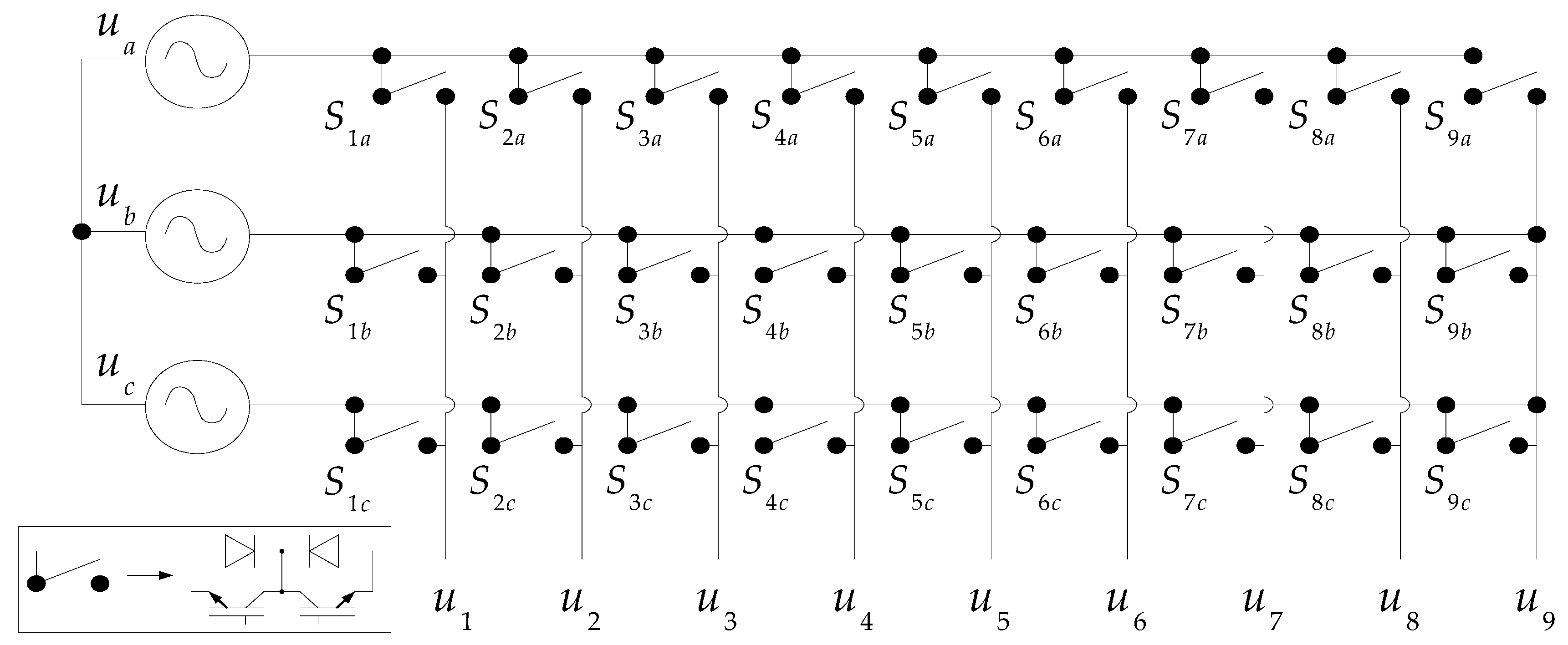
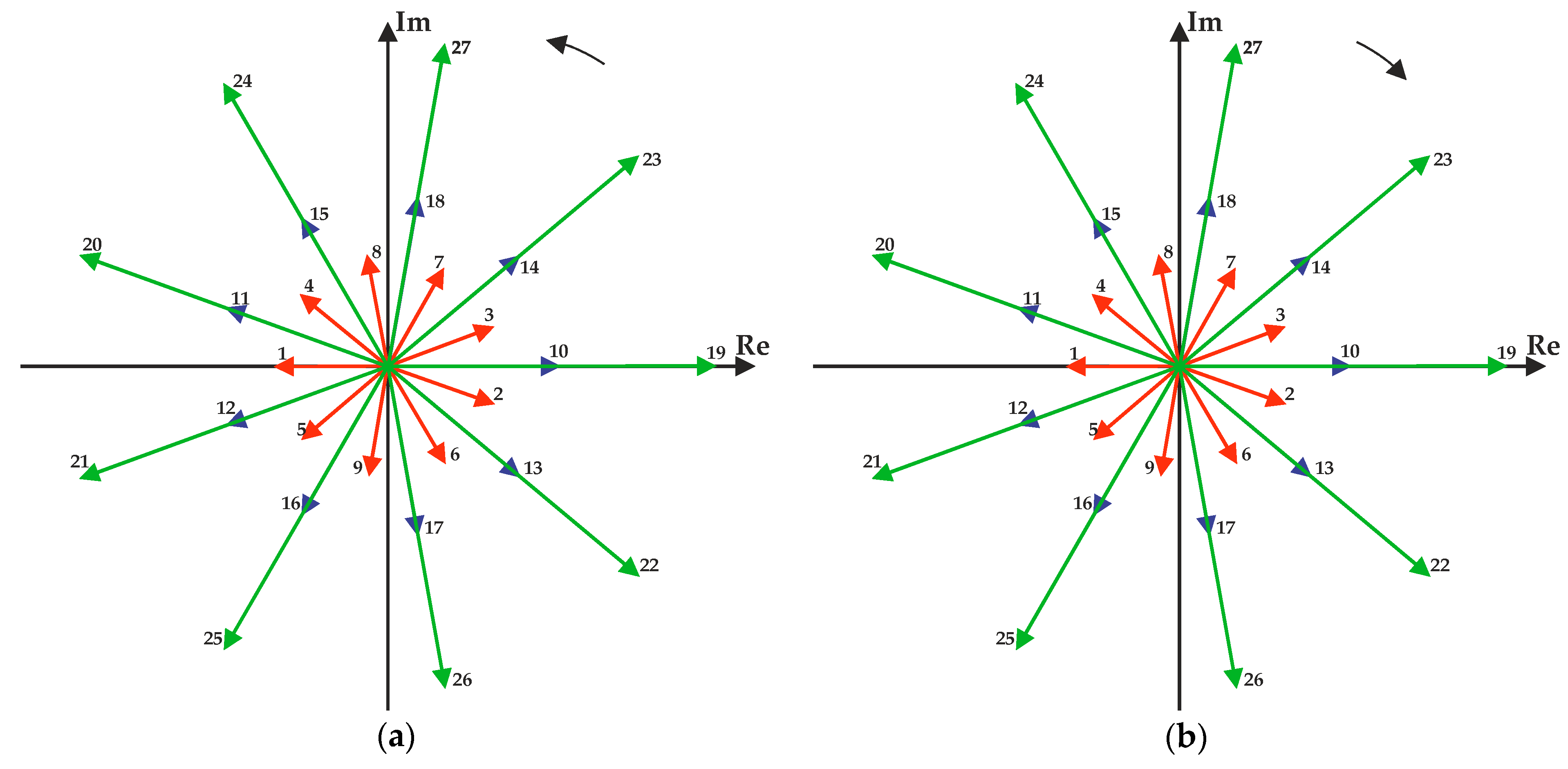

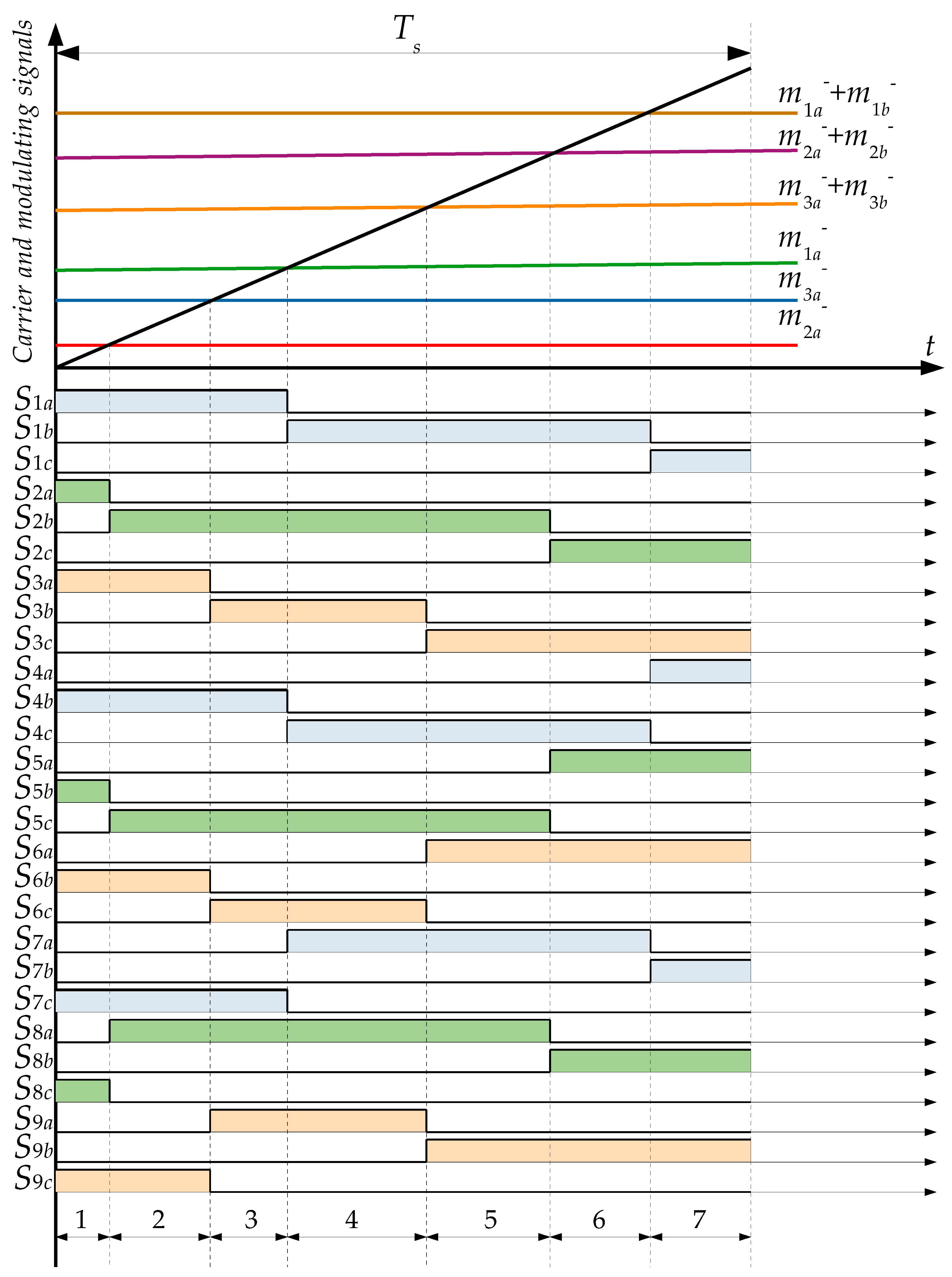
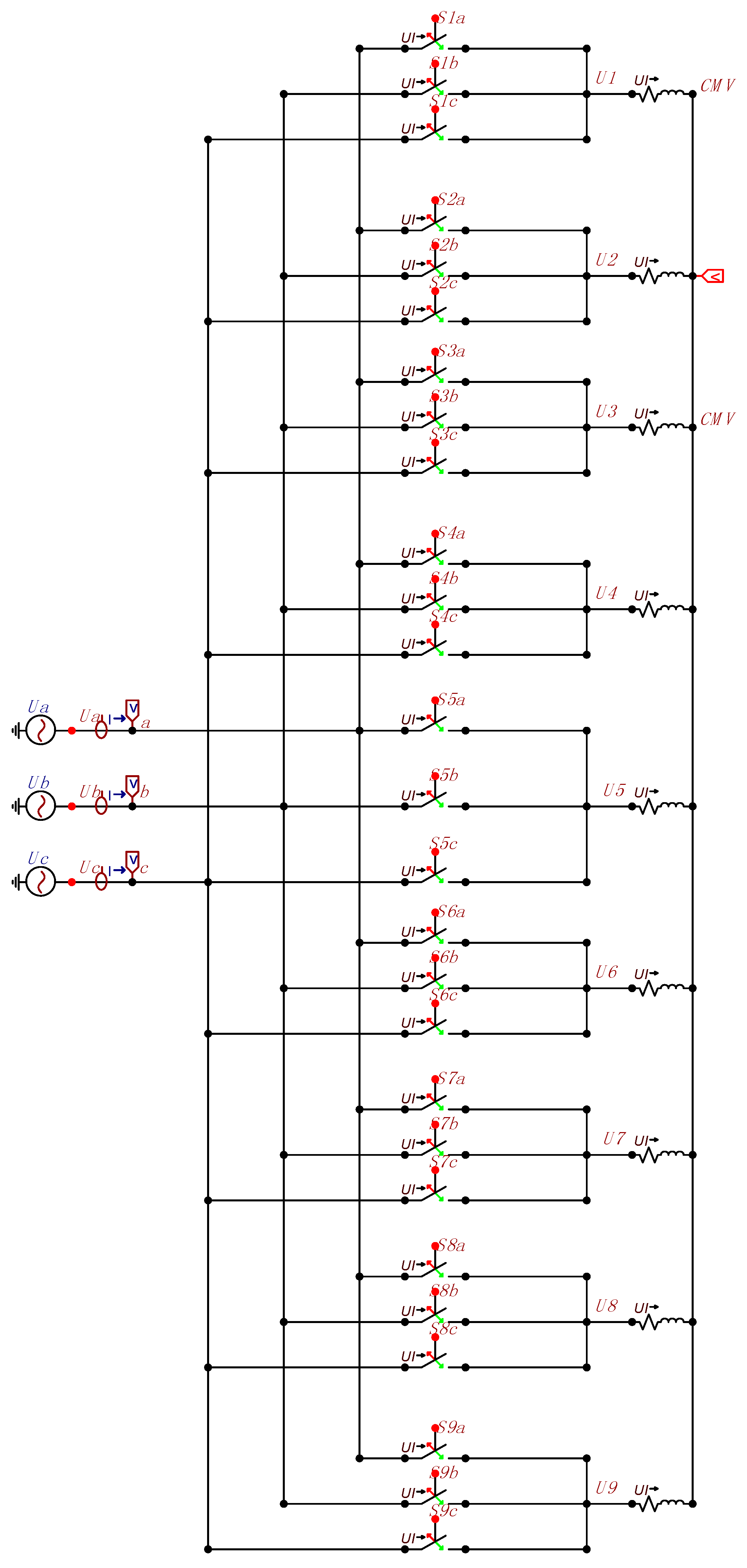
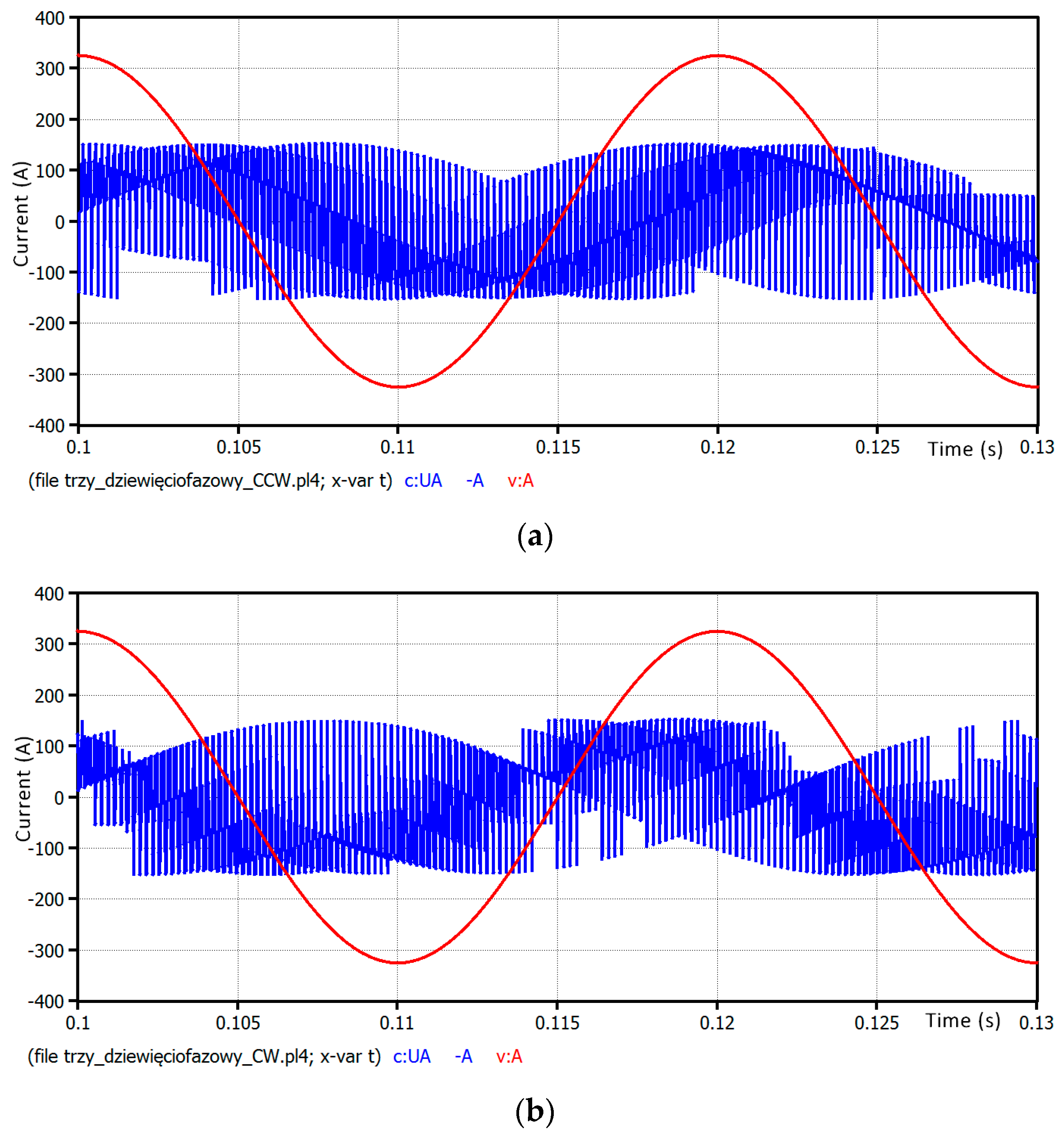

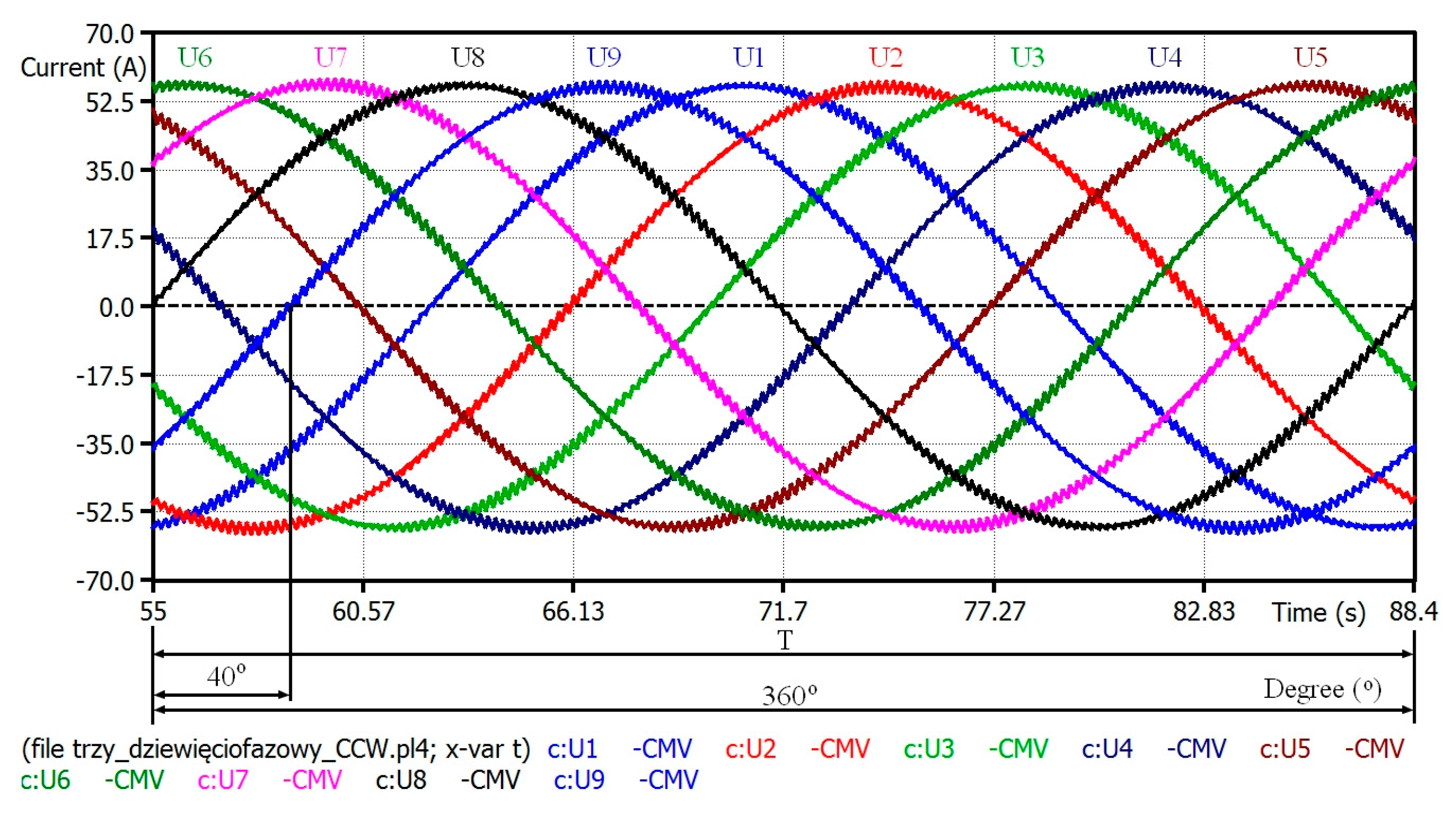
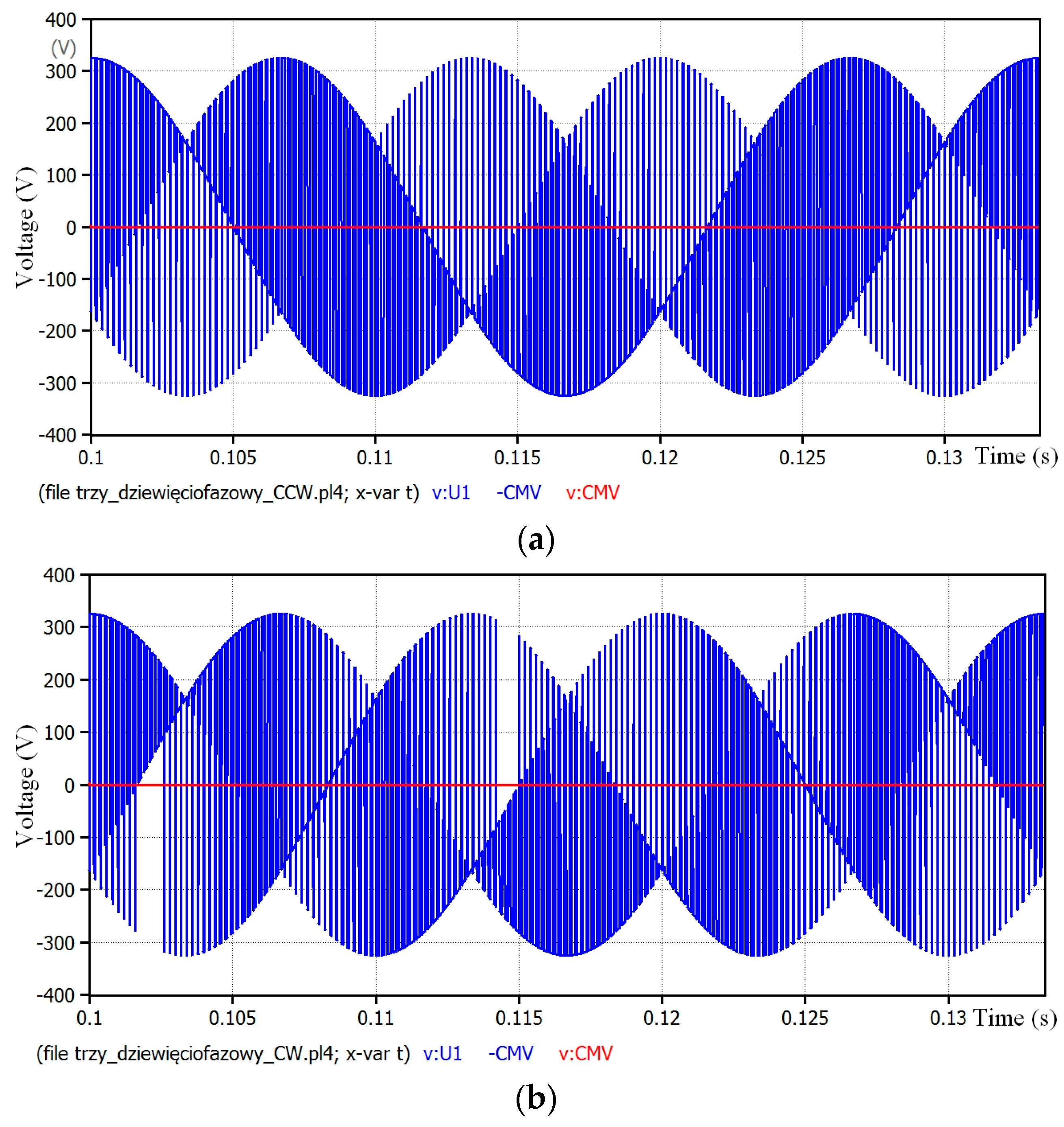
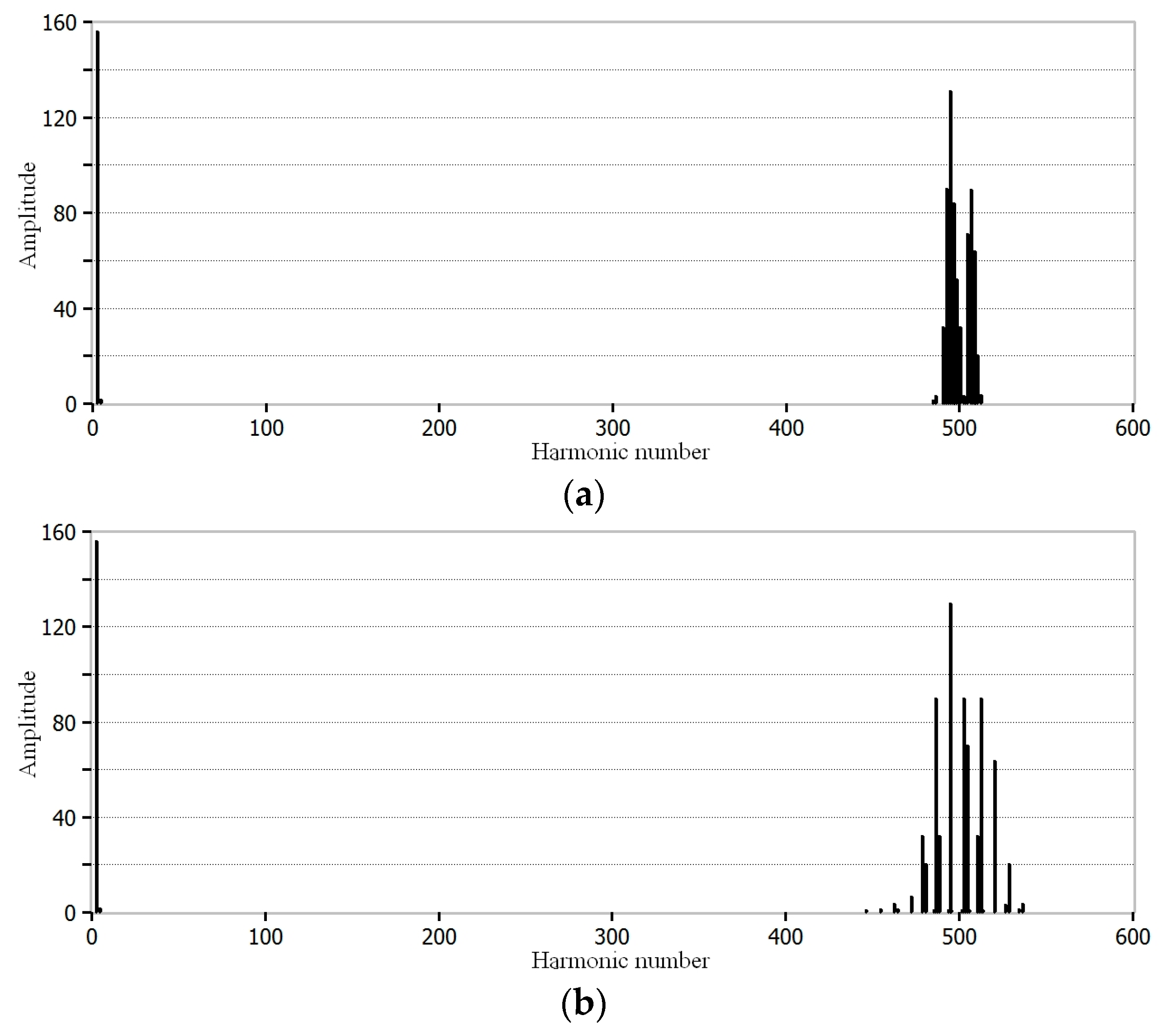
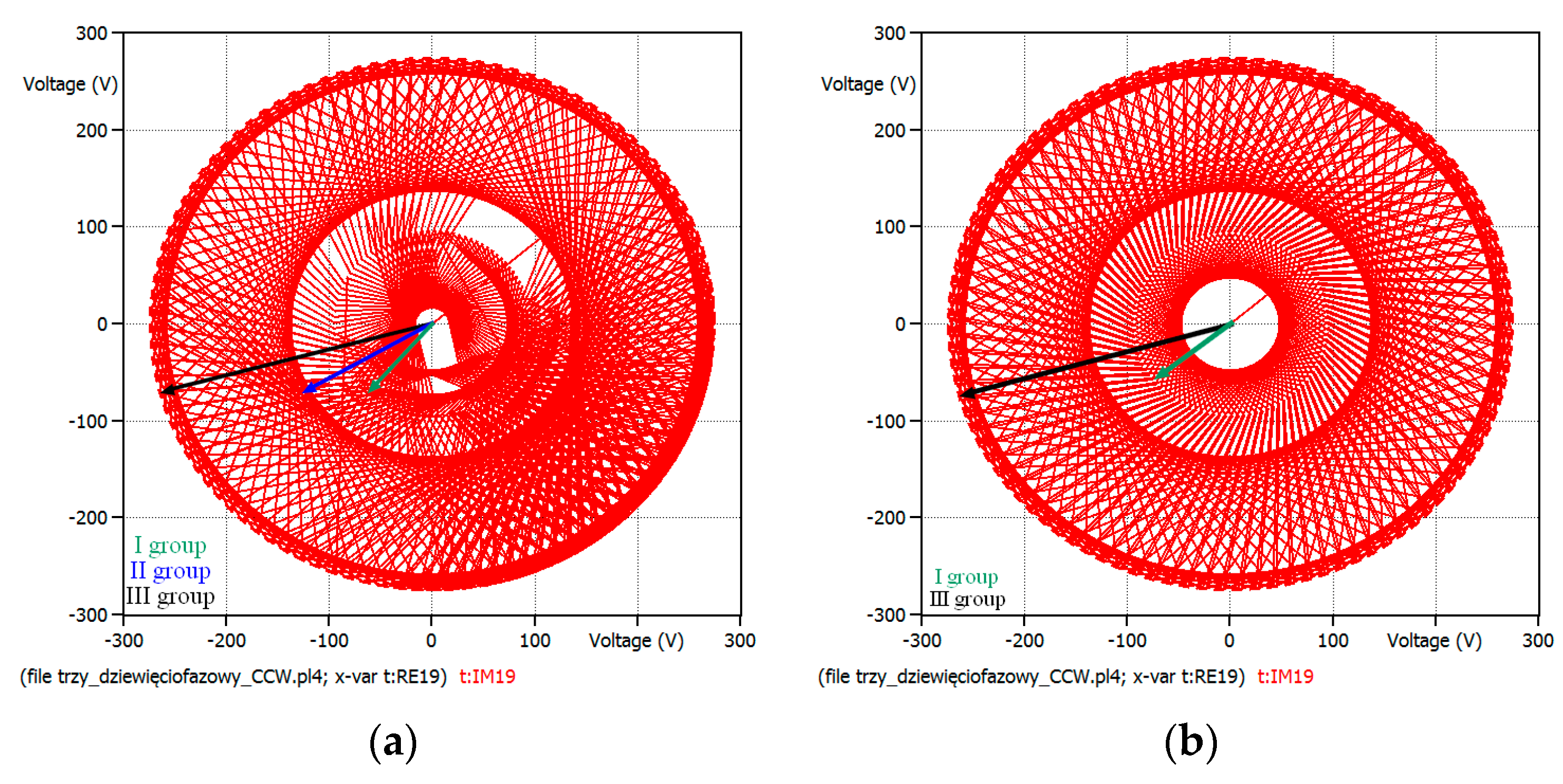
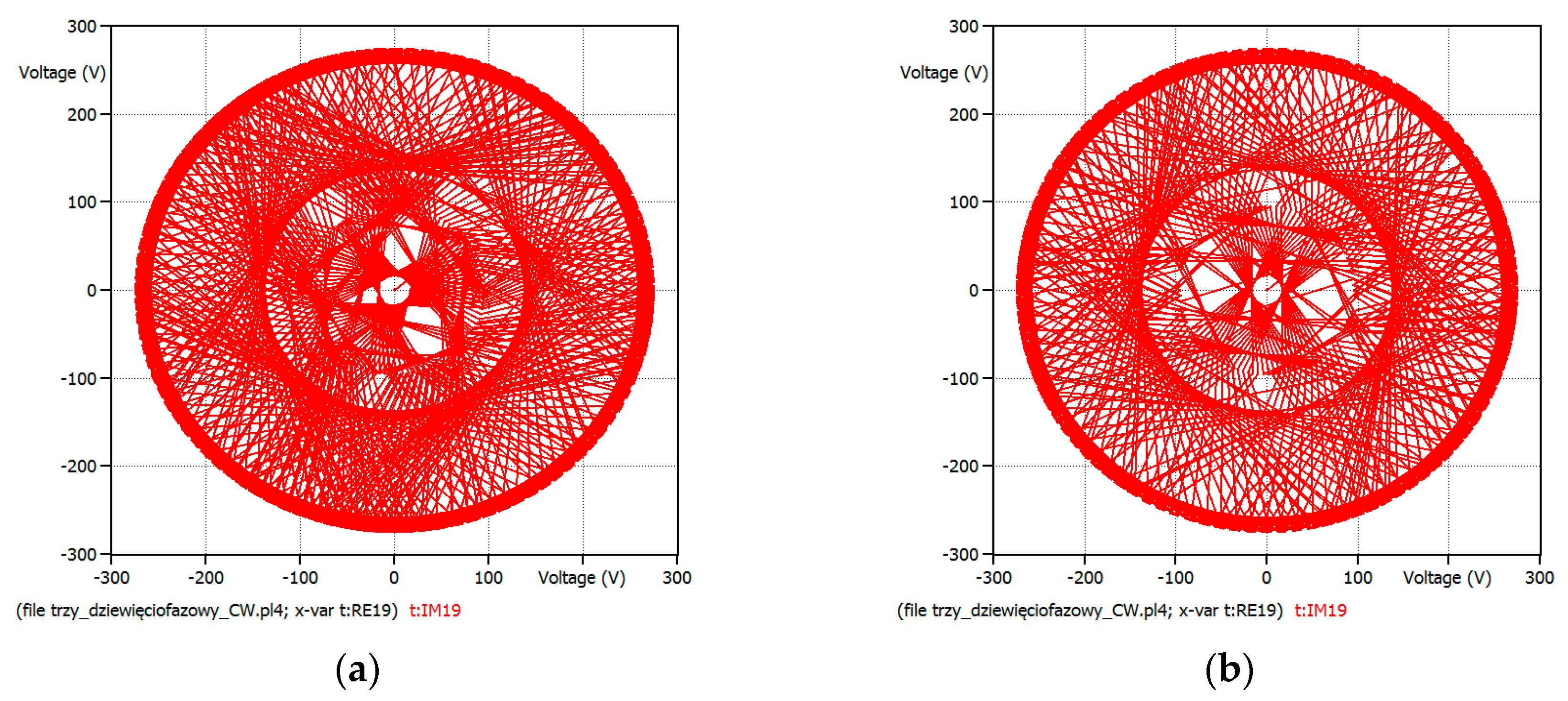
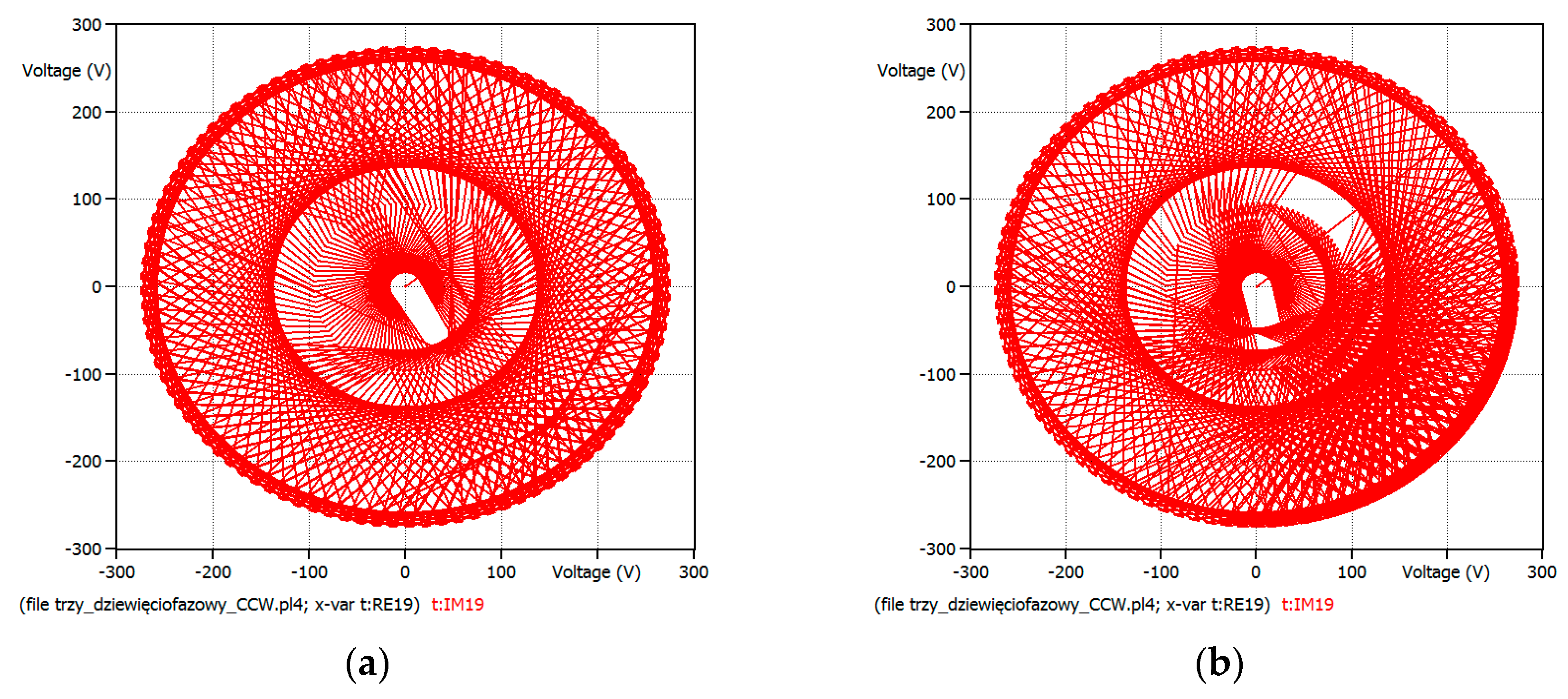
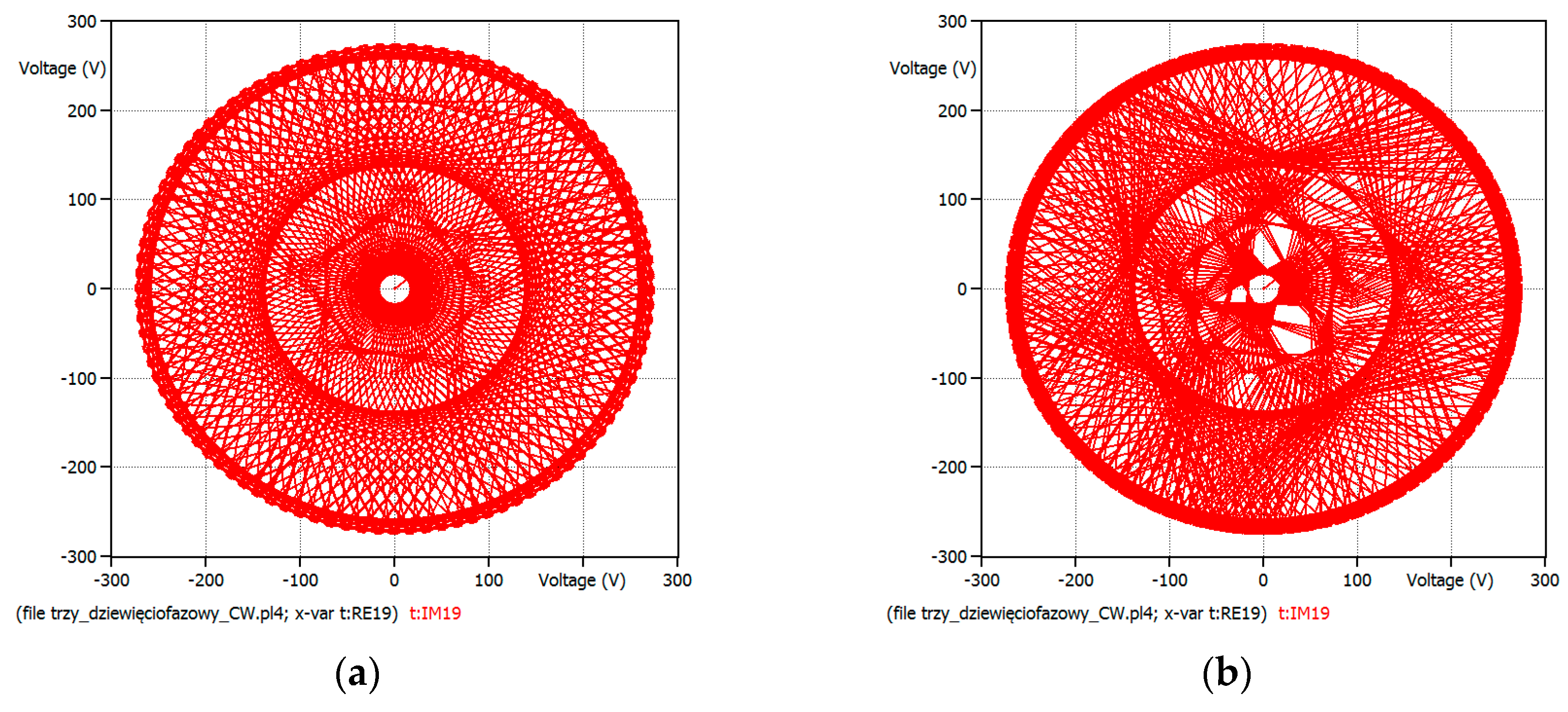
| Group Number | Sub-Groups | Switching Combination in one Sub-Group | Total Switching Combinations |
|---|---|---|---|
| 1 | {9,0,0}; {0,9,0}; {0,0,9} | 1 | 3 |
| 2 | {8,0,1}; {8,1,0}; {0,1,8}; {0,8,1}; {1,8,0}; {1,0,8} | 9 | 54 |
| 3 | {7,0,2}; {7,2,0}; {2,7,0}; {2,0,7}; {0,7,2}; {0,2,7} | 36 | 216 |
| 4 | {7,1,1}; {1,7,1}; {1,1,7} | 72 | 216 |
| 5 | {6,0,3}; {6,3,0}; {0,6,3}; {3,6,0}; {3,0,6}; {0,3,6} | 84 | 504 |
| 6 | {6,1,2}; {6,2,1}; {1,6,2}; {2,6,1}; {1,2,6}; {2,1,6} | 252 | 1512 |
| 7 | {5,0,4}; {5,4,0}; {0,5,4}; {4,5,0}; {0,4,5}; {4,0,5} | 126 | 756 |
| 8 | {5,1,3}; {5,3,1}; {3,5,1}; {1,5,3}; {1,3,5}; {3,1,5} | 504 | 3024 |
| 9 | {5,2,2}; {2,5,2}; {2,2,5} | 756 | 2268 |
| 10 | {4,4,1}; {4,1,4}; {1,4,4} | 630 | 1890 |
| 11 | {4,3,2}; {4,2,3}; {3,4,2}; {2,4,3}; {2,3,4}; {3,2,4} | 1260 | 7560 |
| 12 | {3,3,3} | 1680 | 1680 |
| Summarized switching combinations | 19,683 | ||
| Clockwise Rotating Vectors (CW) | Counterclockwise Rotating Vectors (CCW) |
|---|---|
| I Group | |
| II Group | |
| III Group | |
| Source | |
| Input voltage Uf (phase RMS) | 230 V |
| Input frequency f | 50 Hz |
| Load | |
| Resistance R | 2 Ω |
| Inductance L | 10 mH |
| Control | |
| Carrier frequency fc | 5 kHz |
| Output frequency fo | 30 Hz |
| Voltage transfer ratio kU | 0.5 |
| Input displacement angle φi | for CW: φi = -φo |
| for CCW: φi = φo | |
© 2020 by the authors. Licensee MDPI, Basel, Switzerland. This article is an open access article distributed under the terms and conditions of the Creative Commons Attribution (CC BY) license (http://creativecommons.org/licenses/by/4.0/).
Share and Cite
Rząsa, J.; Sztajmec, E. Elimination of Common Mode Voltage in the Three-To-Nine-Phase Matrix Converter. Energies 2020, 13, 631. https://doi.org/10.3390/en13030631
Rząsa J, Sztajmec E. Elimination of Common Mode Voltage in the Three-To-Nine-Phase Matrix Converter. Energies. 2020; 13(3):631. https://doi.org/10.3390/en13030631
Chicago/Turabian StyleRząsa, Janina, and Elżbieta Sztajmec. 2020. "Elimination of Common Mode Voltage in the Three-To-Nine-Phase Matrix Converter" Energies 13, no. 3: 631. https://doi.org/10.3390/en13030631
APA StyleRząsa, J., & Sztajmec, E. (2020). Elimination of Common Mode Voltage in the Three-To-Nine-Phase Matrix Converter. Energies, 13(3), 631. https://doi.org/10.3390/en13030631






